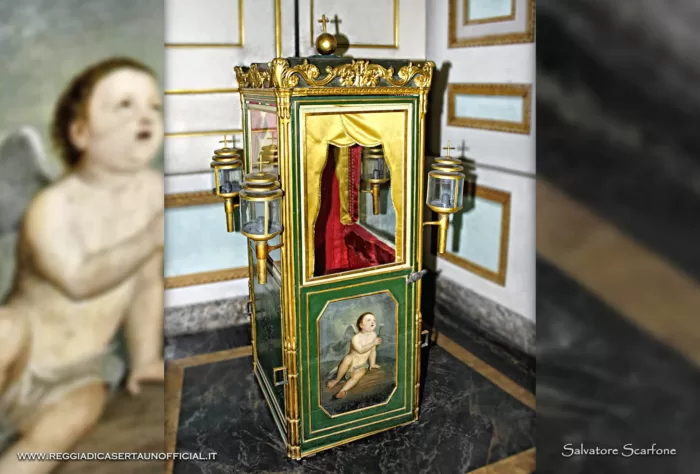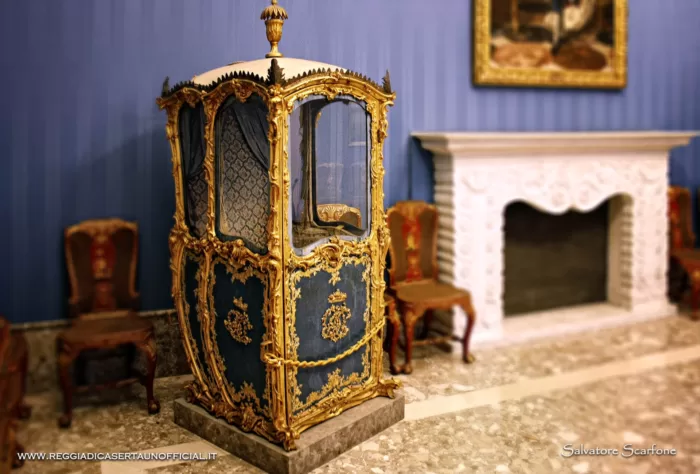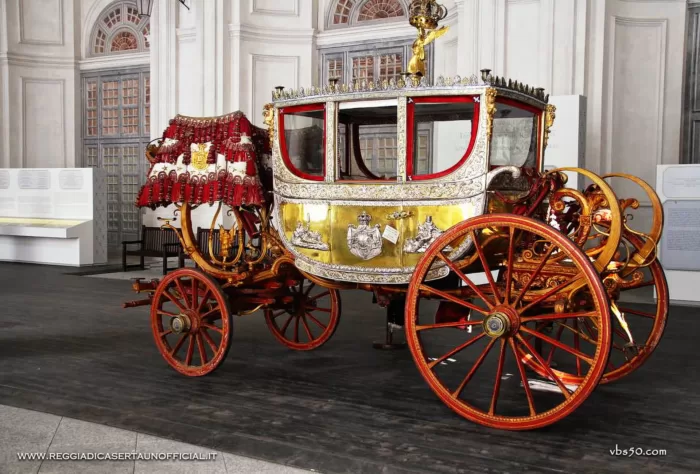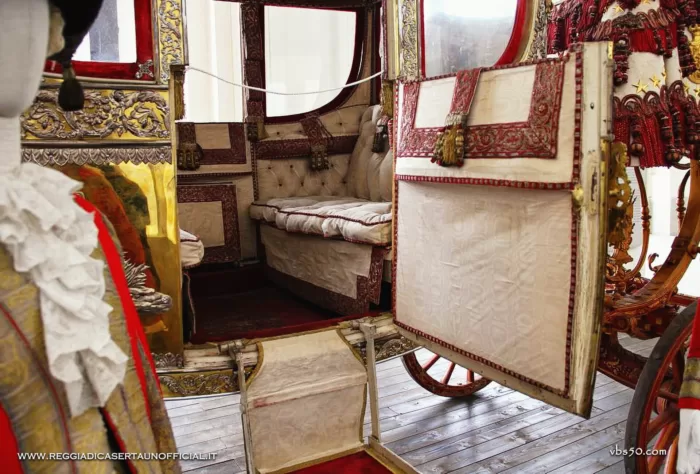Sedan chairs and Neapolitan carriages
Sedan chairs and Neapolitan carriages were famous in the eighteenth century for the harmony of the design, the refinement and magnificence of the design and the lacquers.
“One travels only on chairs carried by porters […] nothing equals the beauty of these golden carriages in which the ladies of the court are transported; the valets on foot, the porters dressed in gala liveries, the pages, the richly dressed gentlemen who escort the chairs, give the whole procession an air of truly imposing magnificence”. (Marquis de Sade, 1776)
The sedan chairs
Sedan chairs and Neapolitan carriages were famous in the eighteenth century. Among the travelers who spoke of them there was also the Spaniard Leandro Fernàndez de Moratin, in Naples in 1793-94, who stated that they could compete for the harmony of the design, the refinement of the ornaments and the magnificence of the lacquers with those of any other city. Many were built for real use, decorated by talented artists. King Charles III of Bourbon owned two that belonged to the Farnese family and ordered another from Paris, with green velvet linings.
Luigi Vanvitelli had a carriage gilded by a certain Simone Girari in 1759. In Spain, in 1759, Maria Amalia had one of her carriages painted by Mattia Gasparini, a brilliant plasterer, ornamentist and draftsman. In 1769 Gennaro Di Fiore was paid “for the drawings and models of the two carriages for transporting the dogs” of Ferdinand IV, painted by Giuseppe Funari.
Fedele Fischetti and Francesco Solimena decorated carriages and sedan chairs, while the carving work was mostly done by expert cabinet makers, including Gennaro di Fiore.
The sedan chairs of Charles III and Queen Amalia are kept in the Capodimonte palace: the latter is precious in the elegance of the shapes and in the pictorial decoration of Solimena, more sober in color but equally rich in the movement of scrolls and scrolls that of the king. At the time of Charles III and Ferdinand IV, sedan chairs were also used in processions in Naples.
Alongside these, however, there were also simpler ones, which were used by judges, doctors, priests, etc., for the exercise of their professions (in the Messina museum, in the Sperlinga palace in Palermo, lined in leather with bronze friezes). The use of sedan chairs was such, in the sec. XVIII, that even in the convents abbots and abbesses were brought there and on the sedan chair those sentenced to death were carried to the place of execution. Even in the first half of the century XIX we find the sedan chairs. The duchesses of the first empire had the Napoleonic battles of Marengo, Austerlitz, Jena, etc. painted there by Vincenzo. Bellini the scenes of the Sonnambula and Norma. In Naples, the use of the sedan chair lasted until about 1830, limited however to baptism ceremonies (see the simpler one in terms of shape and sober decoration in the museum of S. Martino). Until 1860 in the Kingdom of the Two Sicilies, on holy Thursday the royals and the procession used to go solemnly in sedan chairs to visit the churches.
Of this use, now completely disappeared, survive the sedan chair that follows the canon with the sacred relics in the procession of S. Gennaro in Naples (from the end of the seventeenth century, decorated with bronze friezes and reliefs with the miracles of the saint) and those of the Vatican . The latter, all lined with velvet or red damask, adorned with lace and gold fringes, decorated in the sky with the dove of the Holy Spirit, are used to transport the pontiff from the Vatican to the Basilica.
King Charles’ sedan chair in the Capodimonte Museum
The neapolitan carriages
This carriage is an example of the quality of Duosiclian carriages. This luxury sedan (not present in the Royal Palace of Caserta) belonged to Ferdinand II of Bourbon (1810-1859), king of the Two Sicilies. Built in the Royal Palace of Naples, it dates back to 1838, and was created by the royal craftsmen, the builder Salvatore Emmanuele, and the painter Raimondo Pionica.
It was used in important social ceremonies: in fact, the use of the sedan is known for the visit of the royal family to the sanctuary of Piedigrotta on 8 September of each year; moreover, the carriage was used for two solemn occasions, when Ferdinand II went to the Basilica of S. Francesco di Paola to swear the Constitution (1848) and to lead Francesco II to the Cathedral after his ascension to the throne (1859).
The carriage was still in Naples in 1862, despite the fact that immediately after the conquest of the Kingdom it had already been modified by adding the coats of arms of the new rulers, the Savoys. It was later used by the Savoys in the most important gala ceremonies. It is now in Florence.
Structure
The chariot is made of carved wood and iron painted red with gilded motifs. Carved wooden arms ending in the shape of a griffin’s head support the coachman’s seat which is upholstered in crimson silk, bordered in silk and spun silver and decorated with three series of tassels, alternated with embossed and gilded copper stars. The inside of the case is white silk moiré trimmed with crimson braid, fringe, and tassels in silver and gold. On the ceiling a large geometric rosette embroidered in crimson silk, spun silver and sequins. The case is in gilded copper with applications on the sides in embossed silver depicting the allegories of Naples and Palermo, personified by two old sovereigns bearing the emblems of the two cities. In the centre, the Savoy coat of arms, applied later, when, with the annexation of the Kingdom of the Two Sicilies to the Kingdom of Italy, the carriage became part of the Savoy heritage. Above the saloon a winged figure of Fame in gilded brass holds up the royal crown adorned with imitation colored stones.
External Link






